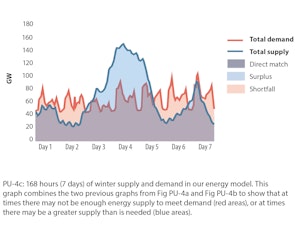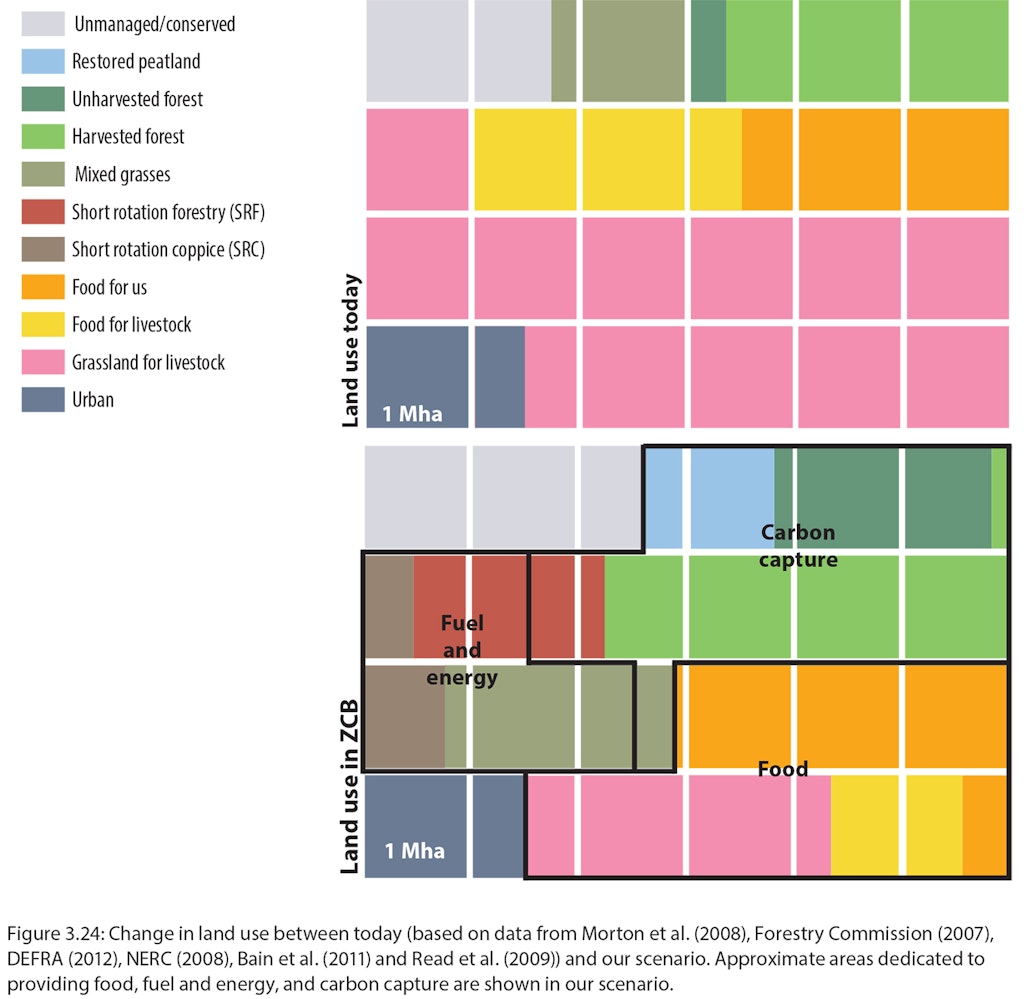
Rising to the Climate Emergency
Executive Summary
Zero Carbon Britain: Rising to the Climate Emergency models a technically robust endpoint where we have achieved net zero greenhouse gas emissions – let’s call this ‘zero carbon’.
Our work clearly demonstrates that we already have the tools and technology needed to efficiently power the UK with 100% renewable energy, to feed ourselves sustainably and so to play our part in leaving a safe and habitable climate for our children and future generations.
For download
Addressing climate breakdown
People all over the world are feeling the effects of climate breakdown, from unprecedented heatwaves, droughts and massive wildfires to some of the most damaging floods and storms ever seen. The warnings from the scientific community are now becoming real life experiences. The current UK greenhouse gas emissions target of net zero by 2050, though ambitious in comparison to some other countries, does not offer rapid enough reductions to provide a good chance of avoiding extremely dangerous climate breakdown. Neither does it adhere to what might be termed the UK’s ‘fair share’ of the remaining global carbon budget.
Net zero starts now
Zero Carbon Britain: Rising to the Climate Emergency explores how we can do what we know is necessary, clearly demonstrating that we can achieve net zero emissions without relying on the promises of future technology. By making changes to our buildings, transport systems, land use and behaviour, and by investing in a variety of renewable energy technologies, we can achieve a zero carbon transition while building in a wide range of additional benefits.
A blueprint for action
The report provides a blueprint to open new conversations around the scale and speed of change we need to deliver if we are to rise to the climate emergency.
It can be used as a template to help citizens and local and national policymakers develop and deliver zero carbon action plans.
How can we reach net zero?
By using energy more efficiently we can power down demand by 60%. At the same time, we can power up the UK’s renewable energy resources to replace fossil fuels. And by making changes to our agricultural systems we could then balance out the remaining 8% of emissions from non-energy processes (such as cement production or methane from livestock) by removing greenhouse gases from the atmosphere through natural carbon capture from forests and restored peatlands. This would take us to net zero emissions overall.

Powering down our energy demand
Our current lifestyles use far more energy than we actually need. CAT’s Zero Carbon Britain research shows that we could reduce our energy demand by around 60%, with particularly large savings in heating buildings and in transport.
- Buildings: having high ‘Passivhaus’ standards for new buildings, retrofitting all existing buildings, and improving internal temperature control would reduce energy demand for heating by around 50%.
- Transport: reducing how much we travel, and changing how we travel – with more use of public transport, walking, cycling, switching to efficient electric vehicles and two thirds less flying – would reduce energy demand for transport by 78%.

Powering up renewable energy
It is possible to supply 100% of the UK’s ‘powered-down’ energy demand with renewable and carbon neutral energy sources, without fossil fuels and without nuclear.
In the Zero Carbon Britain energy scenario:
- Many different renewable energy sources suited to the UK – solar, geothermal, hydro, tidal and others – are used to produce electricity and heat.
- Wind energy – both offshore and onshore – plays a central role, providing around half of the energy supply.
- Most of the energy in this scenario (around 66%) is produced in the form of electricity.
- Carbon neutral synthetic fuels play an important role where it is not possible to use electricity – for example, in some areas of industry and transport, and as back up for our energy system.

The important question for a 100% renewable energy system is not if we can produce enough energy but whether we can produce enough energy at all times – even when the wind isn’t blowing, the sun isn’t shining and our energy demand is high.
Hourly modelling of the renewables mix in the Zero Carbon Britain scenario shows a surplus of energy 74% of the time.
We ensure there is enough energy at other times by:
- Shifting energy demand using ‘smart’ appliances and using batteries, pumped storage and heat storage for short-term energy storage over hours or days.
- Using hydrogen and carbon neutral synthetic gas (which can be dispatched quickly into the electricity grid when we need it) for long-term energy storage over weeks or months.
This research suggests ‘baseload’ power that provides a continuous supply of electricity but can only respond slowly (nuclear, for example) doesn’t work well with a highly variable renewable energy system, as it leads to further overproduction when renewables already exceed demand.
Hourly energy model
The Zero Carbon Britain energy model is one of the most detailed studies to date on balancing demand and supply in a renewable energy system. It uses hourly weather data (sunlight, wind speeds, temperatures, etc.) from over the ten-year period of 2002 to the end of 2011 – a total of almost 88,000 hours – to test renewable energy mixes under real life conditions

Energy flows in our scenario – from supply to demand (figures are in TWh/yr)

Land Use
Through ‘powering down’ demand and ‘powering up’ renewable supply, the UK’s emissions can be significantly reduced save a few industrial and waste management processes that still emit residual greenhouse gases. However, there are also emissions associated with food production, land use changes and land management practices – this accounts for around 10% of current UK emissions.
Agricultural systems are threatened with reduced productivity due to a decline in the numbers and variety of plants and animals in farmland and the surrounding environment. This variety of life is necessary for efficient food production. Therefore, our land management practice must include restoring essential biodiversity.
Our model explores how we can achieve this whilst also reducing agricultural emissions, providing a healthier mix of foods, reducing unnecessary food imports, producing building materials, providing UK sourced biomass, and increasing natural carbon capture to ‘balance’ our residual emissions. In doing this, the UK will become more self-reliant and can clean up its own mess within its own territory. This is a vital piece in the net zero carbon jigsaw.
The use of land explored in the Zero Carbon Britain model will offer a healthier mix of food, plus backup energy supply, and will provide natural carbon capture, which allows the UK to be truly net zero carbon.
A healthy low carbon diet
Through dietary change, food waste reduction and improved agricultural practices we could provide a healthy, sustainable diet for the whole UK population.
These changes would mean that:
- Greenhouse gas emissions from agriculture would be reduced by 57% from 2017 levels. This represents only emissions produced ‘on the farm’, as food processing and distribution are taken into account in ‘powering down’ and ‘powering up’.
- The UK could become more self-reliant in food, reducing imports from 42% to 17%, and so reducing the impacts of food production for our
consumption elsewhere in the world. - Our health would be improved by eating a better and more balanced diet.
- 75% of the land currently used for grazing livestock could be repurposed, freeing up space for a range of other uses, which could also offer new income streams to farmers.
The modelled dietary change contains significantly less protein from meat and dairy (which have high emissions and use a lot of land) and more from plant-based sources like beans, nuts, cereals and vegetables.
Food and diets model
The Zero Carbon Britain food and diets model combines data describing the nutritional qualities of the foods we eat, their land requirements and the greenhouse gases emitted in producing them. This model can then be used to assess the impacts of dietary change.

Diversifying our land use
Making these changes would mean that we have enough land in the UK not only for producing food but to offer new potential income streams:
As well as being used directly as a fuel, UK sourced biomass can be combined with hydrogen from surplus renewables to make carbon neutral synthetic gas and liquid fuels, which increases the amount of fuel produced per acre of land. These are ‘carbon neutral’ as the greenhouse gases they contain were initially captured by the biomass as it grew, resulting in no net increase in the atmosphere.
Forest area is doubled to 24% of the land area of the UK – roughly one third is unharvested and two-thirds harvested for timber. These forests, the wood products they produce and the restoration of 50% of UK peatlands, results in the capture of around 47 MtCO2e on average every year. This is required to balance the residual emissions in the scenario and so make the UK net zero carbon.
The changes would also provide more room for biodiversity in wild, restored, conserved or protected areas.

Using Zero Carbon Britain
A great many people and organisations across the UK are working alongside their local governments to explore zero carbon transitions in transport, energy, buildings, food, land use and waste. Not only can we deliver this through collective action plans, we can also make the individual changes which directly reduce our own emissions, and so transform how we relate to climate breakdown personally.
How you use the report will depend on scale, location and circumstance, but here are some common approaches:
- Get informed and get skilled
- Get connected – join or start a local zero carbon group
- Map out key collaborators
- Make an action plan
- Minimise energy demand and rethink renewable supply
- Use the savings to help fund new projects
- Learn by doing
- Share your experiences
Join the change
While the impacts of individual changes are, of course, relatively small, as more and more of us scale these up they normalise emission reduction behaviours, empower people, help change social and political norms and so increase ambition for policy shifts.
Sharing Zero Carbon Britain can inform ambitious practical actions and policy shifts by clearly demonstrating:
- All the technologies needed to power down demand and power up clean energy are ready and waiting.
- Changes in land use, reduced food imports and healthier diets are a key part of the plan.
- Action on climate change can provide many additional benefits, including improved health and wellbeing, better housing and enhanced biodiversity.
Clearly, there is no single technology, policy or action that can prevent climate breakdown. It will require many people, from all walks of life, working together to bring about the change we need to see.
So let’s come together at individual, local, national and international levels – and collectively rise to the climate emergency!
For download
Email sign up
Stay up to date with all the latest from the Centre for Alternative Technology and our Zero Carbon Britain research project.



